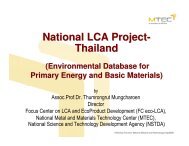ILCD Handbook: Framework and requirements for LCIA models and ...
ILCD Handbook: Framework and requirements for LCIA models and ...
ILCD Handbook: Framework and requirements for LCIA models and ...
Create successful ePaper yourself
Turn your PDF publications into a flip-book with our unique Google optimized e-Paper software.
<strong>ILCD</strong> <strong>H<strong>and</strong>book</strong>: <strong>Framework</strong> <strong>and</strong> <strong>requirements</strong> <strong>for</strong> <strong>LCIA</strong> <strong>models</strong> <strong>and</strong> indicators First edition<br />
Value choices in midpoint <strong>and</strong> damage modelling should be made explicit <strong>and</strong> properly<br />
documented. It is necessary to make a clear distinction between data uncertainties,<br />
modelling assumptions/uncertainties <strong>and</strong> value choices, in order to be transparent<br />
about the different <strong>and</strong> specific sources of uncertainty. decrease the overall uncertainty.<br />
Midpoint approaches also contain value choices, often relying on implicit ones. There is<br />
no unique universal set of "values" 7 .<br />
Care must be taken to ensure comprehensiveness, avoiding considering only partial<br />
in<strong>for</strong>mation on damages (e.g. effect of Climate Change on malaria), excluding other<br />
potentially more important parameters <strong>and</strong> effects (e.g. effects on biodiversity). Hence,<br />
it is useful to retain both midpoint <strong>and</strong> endpoint insights, particularly <strong>for</strong> impact<br />
categories such as ‗Climate Change‘ where the consequences cannot be fully modelled<br />
at this time, bearing in mind additional uncertainties arising on the way from midpoint to<br />
endpoint.<br />
2.2.5 Additional sub-criteria <strong>for</strong> endpoint <strong>models</strong><br />
Do all category indicators <strong>and</strong> characterisation <strong>models</strong> linking midpoint to damage fulfil<br />
the <strong>requirements</strong> of being science based?<br />
How complete is the coverage of the impacts in the modelling from midpoint to<br />
endpoint, in terms of current scientific knowledge?<br />
Is duplication avoided? If not, it should be identified <strong>and</strong>/or removed or accounted <strong>for</strong> in<br />
other ways, where possible.<br />
7 In this sense, Years of Life Lost <strong>and</strong> Years of Life Disabled should be considered first separately <strong>for</strong><br />
impacts on Human Health. Disability weighting <strong>for</strong> non fatal effects could then be explicitly considered<br />
if desired to group diseases together to arrive to DALY. The value choice of assuming equal severity<br />
<strong>for</strong> different diseases is often implicitly made when per<strong>for</strong>ming human toxicity characterisation<br />
modelling based on toxicological effect data alone at midpoint level.<br />
2 Development <strong>and</strong> Application of the Criteria <strong>for</strong> Evaluation 13



